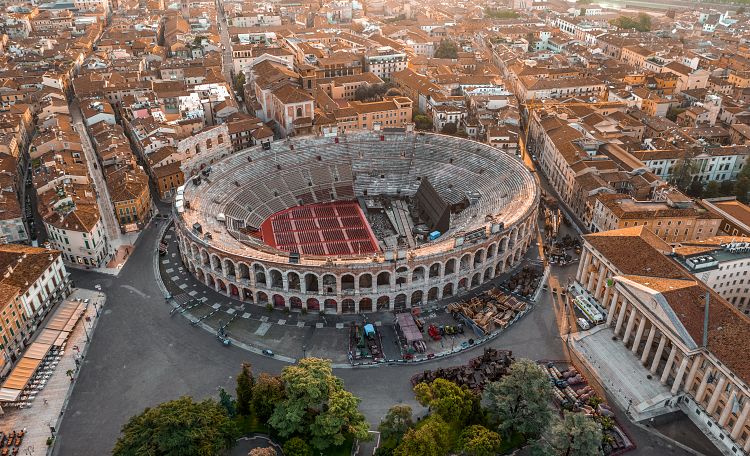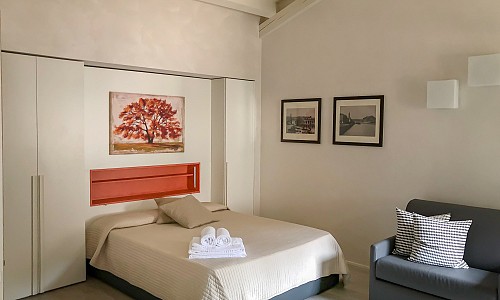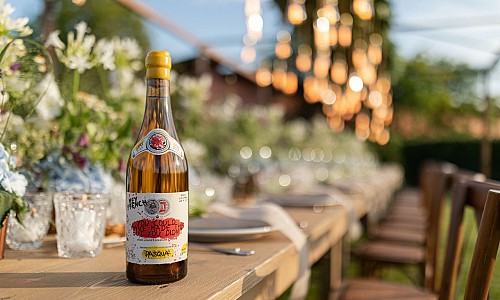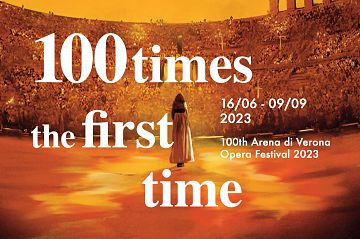Verona Arena: the veronese ''little Colosseum''
- Category What see Lake Garda and Verona
Verona Arena, the famous veronese amphitheater.
Number of views: 16875Agriturismo - Where to stay overnight
Verona, splendida città che dà il nome alla sua provincia, è un crocevia d’arte, cultura e storia: dai fasti romani fino al mito di Romeo e Giulietta. Per la ricchezza e la conservazione dei reperti viene spesso definita una “piccola Roma”. Come la sorella maggiore, infatti, Verona possiede un suo “Colosseo in miniatura”: l’Arena. Pur misurando meno della metà della controparte laziale, l’Arena di Verona continua, dopo duemila anni, a ospitare eventi di ogni genere, dalle grandi produzioni liriche a concerti pop, dimostrando una vitalità unica fra gli anfiteatri romani.
La storia dell'Arena di Verona
Fondata nel I secolo a.C. in posizione strategica lungo le principali vie di comunicazione del Nord Italia, Verona divenne rapidamente una città ricca e popolosa. Nell’arco di un secolo si dotò di monumenti pubblici, templi, fori e luoghi di intrattenimento, fra cui spiccava l’anfiteatro, pensato per celebrare la potenza di Roma e tenere coesa la comunità locale.
Gli spettacoli dei Gladiatori
Nei territori dell’Impero i combattimenti gladiatori – nati probabilmente come riti funebri etruschi o campani – si trasformarono in veri e propri show. Politici e magistrati gareggiavano nell’offrire venationes, naumachie e duelli all’ultimo sangue per ottenere consenso popolare. Serviva dunque un edificio ad hoc: l’anfiteatro, evoluzione del teatro greco “raddoppiato” in forma ellittica. Gli archeologi stimano che ne furono eretti circa 200, molti dei quali ancor oggi ben conservati.
La Costruzione dell'anfiteatro veronese
Come negli stadi moderni, il pubblico sosteneva i propri beniamini con cori e ovazioni; non mancavano risse per i posti migliori o per dispute arbitrali. A causa dell’odore di bestie feroci, sangue e carcasse, gli anfiteatri sorgevano fuori dai centri abitati. Così l’Arena fu costruita a 60‑70 m a sud delle mura cittadine, equidistante da porta Borsari e porta Leoni, risultando facilmente raggiungibile anche dal Lago di Garda e dalla Valpolicella. Isolata nella pianura, la sua mole doveva apparire imponente a chiunque giungesse in città.
La Pietra di Verona
Edifici tanto colossali richiedevano enormi quantità di materiale. Gli ingegneri romani adattavano i progetti alla geologia locale: per l’Arena fu scelta la pietra calcarea della Valpolicella, il celebre Rosso Verona. Compatto, resistente e facile da lavorare, offre cromie che variano dal bianco latte al rosso intenso; ancora oggi è molto richiesto in edilizia e scultura.
La Scuola dei Gladiatori
Scavi ottocenteschi hanno rivelato, accanto all’Arena (nell’area dell’attuale municipio), i resti di un grande edificio identificato come ludus gladiatorius: la palestra dove i gladiatori si addestravano, vivevano e venivano selezionati per i combattimenti.
Mura di Gallieno
Nell’anno 265 d.C. l’invasione degli Alemanni obbligò l’imperatore Gallieno a restaurare in soli sei mesi le difese cittadine, inglobando l’Arena nella nuova cinta muraria. Con i suoi 30 m di altezza, l’anfiteatro avrebbe potuto essere occupato come torre d’assedio; parte dell’anello esterno fu quindi smantellata sia per abbassarne la sagoma sia per riutilizzarne i blocchi.
L'Opera
La prima rappresentazione lirica all’interno dell’Arena risale al 10 agosto 1913, centenario della nascita di Verdi. Il tenore Giovanni Zenatello intuì l’eccezionale acustica del monumento e vi organizzò l’Aida. Il successo fu tale da trasformarsi in un festival annuale, interrotto solo dalle guerre mondiali, che ha portato sul palco artisti del calibro di Maria Callas, Luciano Pavarotti e Plácido Domingo.
L'Arena Oggi
Negli ultimi quarant’anni l’uso dell’Arena si è diversificato: concerti pop, jazz e rock, manifestazioni sportive (come l’arrivo del Giro d’Italia), mostre di presepi, gala dinner e persino spettacoli di pattinaggio su ghiaccio. La capienza varia da 15.000 a 17.000 spettatori poiché il palco occupa parte delle gradinate. Da ottobre ad aprile, senza sedute né scenografie, l’edificio si mostra nella sua forma originaria: un’ellisse di gradoni interrotti da “vomitoria” e una platea sabbiosa che un tempo assorbiva il sangue dei gladiatori. Un terremoto nel 1117 distrusse gran parte dell’anello esterno, lasciando intatta solo l’attuale Ala.
La Leggenda
Per spiegare la costruzione di un’opera così imponente nacque la leggenda del patto col diavolo. Un condannato a morte ottenne la grazia dal governatore promettendo, in una sola notte, di realizzare il più grande edificio mai visto. Aiutato dai demoni, l’opera crebbe velocemente, ma il prigioniero si pentì e invocò la Vergine. Maria anticipò l’alba, costringendo i diavoli a fuggire e lasciando l’anfiteatro incompiuto: così la tradizione giustifica la presenza della solitaria Ala superstite.
Dove dormire:
















